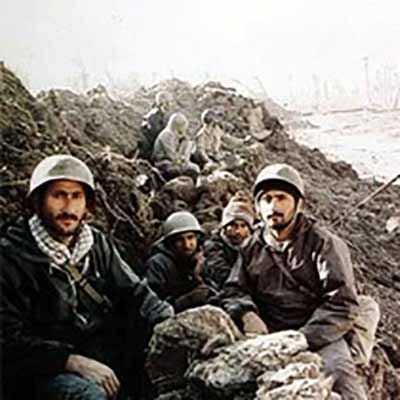Operation Ashura-2
Leila Karimi
267 بازدید
The Islamic Revolutionary Guard Corps carried out Operation Ashura-2 in a limited manner and, with it, intended to keep the front lines in the area of Changuleh, south of the border city of Mehran, active. This operation was conducted in 1985.
In the summer of 1985, the Khatam al-Anbiyah Base - the joint operations center of the Islamic Revolutionary Guard Corps and the Islamic Republic of Iran Army - chose the Changuleh axis for the implementation of the limited operation called Ashura-2. This was done in order to form and prepare the ground for the extensive Operation Fajr-8 and to keep the western front of the country - the border city of Mehran - active. However, Iraq would not be left alone.[1] Following this decision, Operation Ashura-2 was designed on August 14, 1985, with the aim of clearing the desired areas from Iraqi forces and capturing the strategic twin hills and heights 145 and 150 located south of Mehran.
The implementation of the operation was assigned to four companies from the 17th Division of Ali bin Abi Talib and three companies from the 72nd Muharram Armored Brigade of the Islamic Revolutionary Guard Corps.[2]
A tank company with nine tanks from the 72nd Muharram Armored Brigade was also present in the operating forces, which were deployed in the operational area after crossing minefields,[3] barbed wire and other strategic obstacles. The two twin hills and heights of 145 are 150 are west of Dehlran and south of the Changuleh Checkpoint. The Iraqi army monitored the movements of the Iranian forces by creating observatories and listening posts. In terms of the strategic importance of these two hills for Iraq, they were named "Ayun al-Qadisiyah" and the forces of the 114th Iraqi Infantry Brigade were deployed to protect them.
The operation started at 02:00 on August 14, 1985, with the codename “Ya Mahdi”.[4] The forces of the 17th Division of Ali bin Abi Talib were successful in the ridge axis of height 145 and the twin hills, but failed to completely capture height 145 and, without clearing the operational area, they retreated from the obtained positions at around 11:00. The forces of the 72nd Muharram Armored Brigade did not succeed in crossing the minefield at one of the crossings of Tepe Duqlo, while in the other crossing, the forces were forced to withdraw from this front due to the lack of clearing and inability to capture the operation area.[5]
In this operation, Iranian forces attacked the Iraqi positions in the axis of the Shahabi Checkpoint, located west of Dehloran, and destroyed the Iraqi observatories positioned there.[6]
The number of martyrs and missing Iranian forces in the units of the 17th Division of Ali bin Abi Talib was 40, with around 100 getting wounded. The 72nd Muharram Armored Brigade had 60 martyrs and missing and also 100 wounded. A video of the Iranian prisoners from Operation Ashura-2 was broadcasted on Iraqi TV news. In it, about 35 prisoners, most of whom were from the 72nd Muharram Armored Brigade, were seen. In this operation, the number of Iraqi personnel killed and wounded was estimated to be around 400, while their POW’s were between 3 and 9.[7]
In Operation Ashura-2, the forces of the 1st and 2nd Battalions of the 114th Brigade of the 35th Iraqi army were destroyed and their equipment and ammunition were set on fire.[8] A large number of light and medium weapons, several mortars and some ammunition were seized by the Iranian forces.[9]
Iraqi forces attacked at 08:00 on August 14, 1985, by gathering battalions consisting of Mithaq and al-Shahabi commando forces around the height of 145, but they were forced to retreat due to the resistance of the Iranian forces.[10]
Operation Ashura-2 was unsuccessful in terms of attaining the prescribed goals and, in reality, it became an infiltration and harassment operation.[11]
[1] Razzaqzadeh, A., Guide Atlas 3: Ilam in War, Tehran: Revolutionary Guard Center for War Studies and Research, Tehran,
[2]Nakhai, H., & Mashhadi Farahani, H., Iran-Iraq War Chronicle, Book 37: Development of Relations with Asian Powers, Tehran: Islamic Revolutionary Guards Corps War Studies and Research Center, 2003, pp. 718 and 717.
[3] Newspaper of the Islamic Republic, No. 1802, August 26, 1985, p. 2.
[4] Samii, A., Descriptive record of the operations of Islamic warriors during the eight years of holy defense, Tehran: Vali Faqih Agency, Deputy of Publicity and Publications, Ch 1, 1997, p. 206.
[5] Nakhai, H., & Mashhadi Farahani, H., Journal of the Iran-Iraq War, Book 37: Development of Relations with Asian Powers, 2004, p. 718
[6] Islamic Republic newspaper, page 2.
[7] Nakhai, H., & Mashhadi Farahani, H., Journal of the Iran-Iraq War, Book 37, p. 718
[8] Samii, A., Descriptive record of the operations of Islamic warriors during the eight years of holy defense, p. 206
[9] Samii, A., Descriptive record of operations during eight years of holy defense, pp. 206 and 207.
[10] Islamic Republic newspaper, page 2
[11]Nakhai, H., and Mashhadi Farahani, H., Journal of the Iran-Iraq War, Book 37, p. 717.



